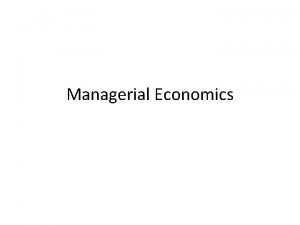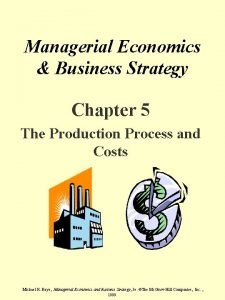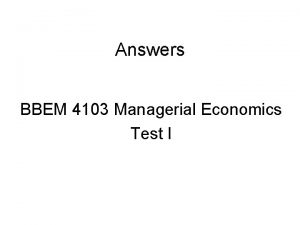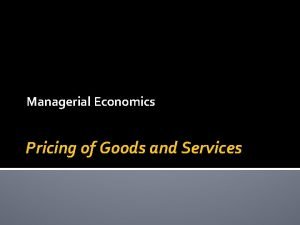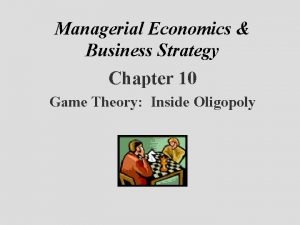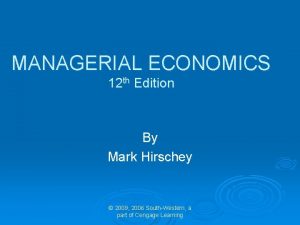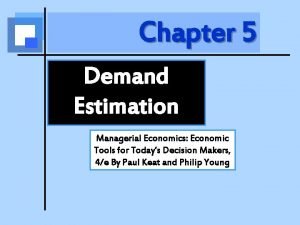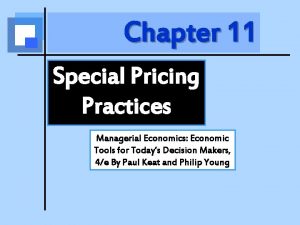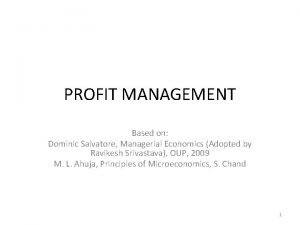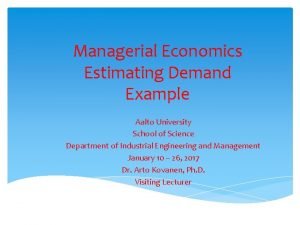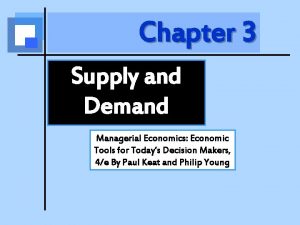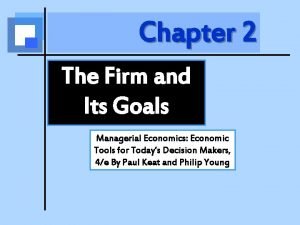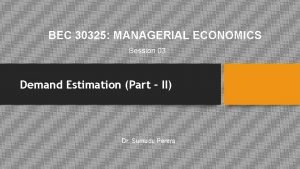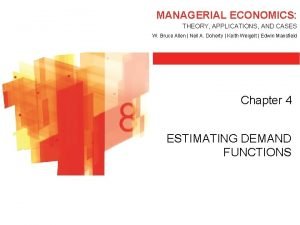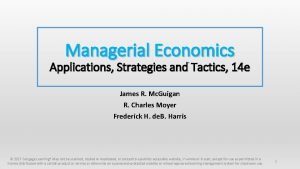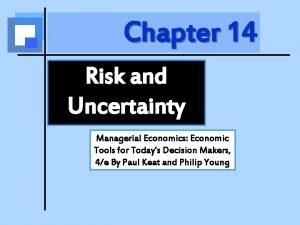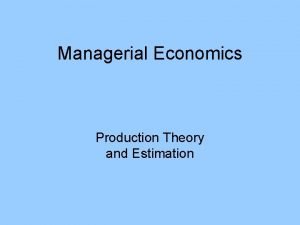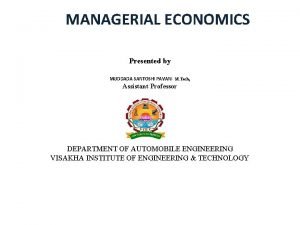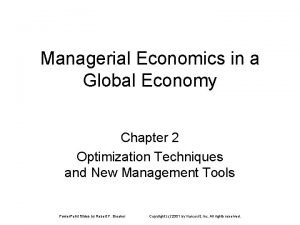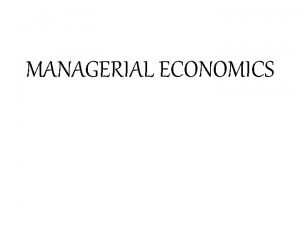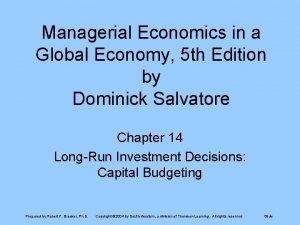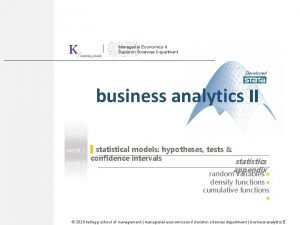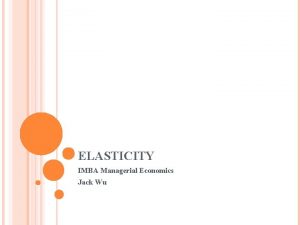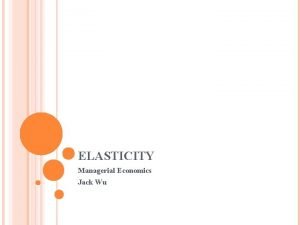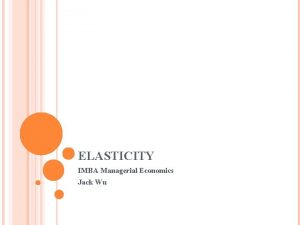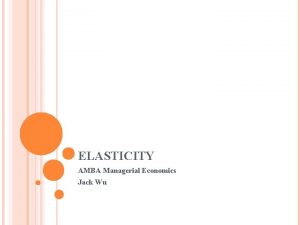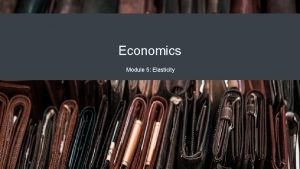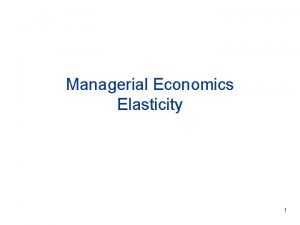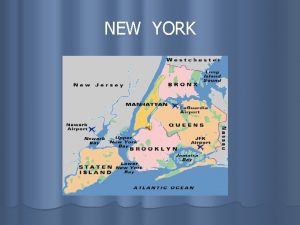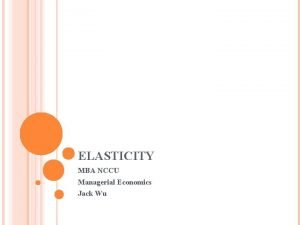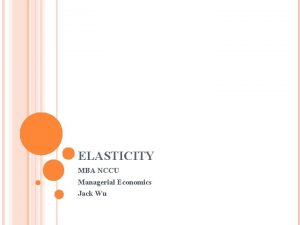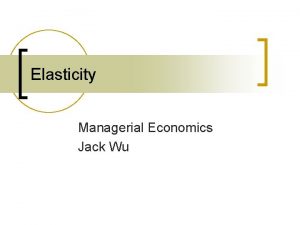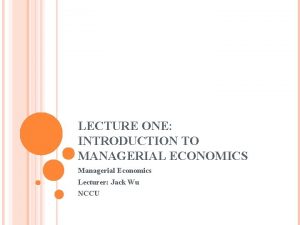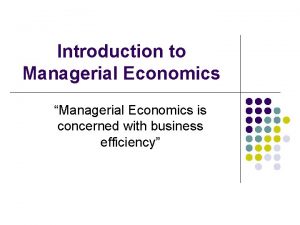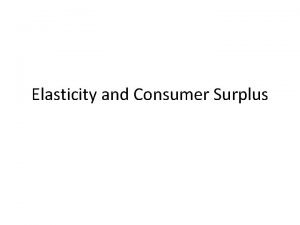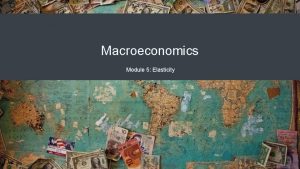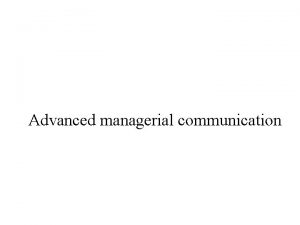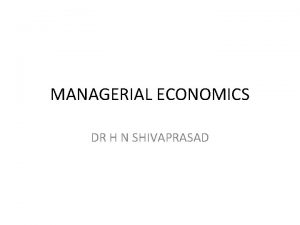ELASTICITY Managerial Economics Jack Wu ELASTICITY NEW YORK







![CALCULATING ELASTICITY Arc Approach: Elasticity={[Q 2 -Q 1]/avg. Q}/{[P 2 -P 1]/avg. P % CALCULATING ELASTICITY Arc Approach: Elasticity={[Q 2 -Q 1]/avg. Q}/{[P 2 -P 1]/avg. P %](https://slidetodoc.com/presentation_image_h2/8f2c5dd7fdbf781f075ec05e61bd0161/image-8.jpg)
![CALCULATING ELASTICITY Point approach: Elasticity={[Q 2 -Q 1]/Q 1}/{[P 2 -P 1]/P 1} % CALCULATING ELASTICITY Point approach: Elasticity={[Q 2 -Q 1]/Q 1}/{[P 2 -P 1]/P 1} %](https://slidetodoc.com/presentation_image_h2/8f2c5dd7fdbf781f075ec05e61bd0161/image-9.jpg)






























- Slides: 39

ELASTICITY Managerial Economics Jack Wu

ELASTICITY

NEW YORK CITY TRANSIT AUTHORITY May 2003: projected deficit of $1 billion over following two years Raised single-ride fares from $1. 50 to $2 Raised discount fares One-day unlimited pass from $4 to $7 30 -day unlimited pass from $63 to $70 Increased pay-per-ride Metro. Card discount from 10% bonus for purchase of $15 or more to 20% for purchase of $10 or more.

NY MTA expected to raise an additional $286 million in revenue. Management projected that average fares would increase from $1. 04 to $1. 30, and that total subway ridership would decrease by 2. 9%.

MANAGERIAL ECONOMICS QUESTION Would the MTA forecasts be realized? In order to gauge the effects of the price increases, the MTA needed to predict how the new fares would impact total subway use, as well as how it would affect subway riders’ use of discount fares. <Note> We can use the concept of elasticity to address these questions.

OWN-PRICE ELASTICITY: E=Q%/P% Definition: percentage change in quantity demanded resulting from 1% increase in price of the item. Alternatively,

OWN-PRICE ELASTICITY: CALCULATION
![CALCULATING ELASTICITY Arc Approach ElasticityQ 2 Q 1avg QP 2 P 1avg P CALCULATING ELASTICITY Arc Approach: Elasticity={[Q 2 -Q 1]/avg. Q}/{[P 2 -P 1]/avg. P %](https://slidetodoc.com/presentation_image_h2/8f2c5dd7fdbf781f075ec05e61bd0161/image-8.jpg)
CALCULATING ELASTICITY Arc Approach: Elasticity={[Q 2 -Q 1]/avg. Q}/{[P 2 -P 1]/avg. P % change in qty = (1. 44 -1. 5)/1. 47 = -4. 1% % change in price = (1. 10 -1)/1. 05 = 9. 5% Elasticity=-4. 1%/9. 5% =-0. 432
![CALCULATING ELASTICITY Point approach ElasticityQ 2 Q 1Q 1P 2 P 1P 1 CALCULATING ELASTICITY Point approach: Elasticity={[Q 2 -Q 1]/Q 1}/{[P 2 -P 1]/P 1} %](https://slidetodoc.com/presentation_image_h2/8f2c5dd7fdbf781f075ec05e61bd0161/image-9.jpg)
CALCULATING ELASTICITY Point approach: Elasticity={[Q 2 -Q 1]/Q 1}/{[P 2 -P 1]/P 1} % change in qty = (1. 44 -1. 5)/1. 5= -4% % change in price = (1. 10 -1)/1= 10% Elasticity=-4%/10%=-0. 4

OWN-PRICE ELASTICITY |E|=0, perfectly inelastic 0<|E|<1, inelastic |E|=1, unit elastic |E|>1, elastic |E|=infinity, perfectly elastic

OWN-PRICE ELASTICITY: SLOPE Steeper demand curve means demand less elastic But slope not same as elasticity

DEMAND CURVES Price perfectly inelastic demand perfectly elastic demand 0 Quantity

LINEAR DEMAND CURVE Vertical intercept: perfectly elastic Upper segment: elastic Middle: Unit elastic Lower segment: inelastic Horizontal intercept: perfectly inelastic

OWN-PRICE ELASTICITIES

OWN-PRICE ELASTICITY: DETERMINANTS availability of direct or indirect substitutes cost / benefit of economizing (searching for better price) buyer’s prior commitments separation of buyer and payee

AMERICAN AIRLINES “Extensive research and many years of experience have taught us that business travel demand is quite inelastic… On the other hand, pleasure travel has substantial elasticity. ” Robert L. Crandall, CEO, 1989

AADVANTAGE 1981: American Airlines pioneered frequent flyer program buyer commitment business executives fly at the expense of others

FORECASTING: WHEN TO RAISE PRICE CEO: “Profits are low. We must raise prices. ” Sales Manager: “But my sales would fall!” Real issue: How sensitive are buyers to price changes?

FORECASTING Forecasting quantity demanded Change in quantity demanded = price elasticity of demand x change in price

FORECASTING: PRICE INCREASE If demand elastic, price increase leads to proportionately greater reduction in purchases lower expenditure If demand inelastic, price increase leads to proportionately smaller reduction in purchases higher expenditure

INCOME ELASTICITY, I=Q%/Y% Definition: percentage change in quantity demanded resulting from 1% increase in income. Alternatively,

INCOME ELASTICITY I >0, Normal good I <0, Inferior good Among normal goods: 0<I<1, necessity I>1, luxury

INCOME ELASTICITY

CROSS-PRICE ELASTICITY: C=Q%/PO% Definition: percentage change in quantity demanded for one item resulting from 1% increase in the price of another item. (%change in quantity demanded for one item) / (% change in price of another item)

CROSS-PRICE ELASTICITY C>0, Substitutes C<0, complements C=0, independent

CROSS-PRICE ELASTICITIES

ADVERTISING ELASTICITY: A=Q%/A% Definition: percentage change in quantity demanded resulting from 1% increase in advertising expenditure.

ADVERTISING ELASTICITY: ESTIMATES Item Market Elasticity Beer U. S. 0 Wine U. S. 0. 08 Cigarettes U. S. 0. 04 If advertising elasticities are so low, why do manufacturers of beer, wine, cigarettes advertise so heavily?

ADVERTISING direct effect: raises demand indirect effect: makes demand less sensitive to price Own price elasticity for antihypertensive drugs Without advertising: -2. 05 With advertising: -1. 6

FORECASTING DEMAND Q%=E*P%+I*Y%+C*Po%+a*A%

FORECASTING DEMAND Effect on cigarette demand of 10% higher income 5% less advertising change elas. effect income 10% 0. 1 1% advert. -5% 0. 04 -0. 2% net +0. 8%

ADJUSTMENT TIME short run: time horizon within which a buyer cannot adjust at least one item of consumption/usage long run: time horizon long enough to adjust all items of consumption/usage

ADJUSTMENT TIME For non-durable items, the longer the time that buyers have to adjust, the bigger will be the response to a price change. For durable items, a countervailing effect (that is, the replacement frequency effect) leads demand to be relatively more elastic in the short run.

Price ($ per unit) NON-DURABLE: SHORT/LONG-RUN DEMAND 5 4. 5 long-run demand short-run demand 0 1. 5 1. 6 1. 75 Quantity (Million units a month)

SHORT/LONG-RUN ELASTICITIES

STATISTICAL ESTIMATION: DATA time series – record of changes over time in one market cross section -- record of data at one time over several markets Panel data: cross section over time

MULTIPLE REGRESSION Statistical technique to estimate the separate effect of each independent variable on the dependent variable = variable whose changes are to be explained independent variable = factor affecting the dependent variable

DISCUSSION QUESTION Drugs that are not covered by patent can be freely manufactured by anyone. By contrast, the production and sale of patented drugs is tightly controlled. The advertising elasticity of the demand for antihypertensive drugs was around 0. 26 for all drugs, and 0. 24 for those covered by patents. For all antihypertensive drugs, the own price elasticity was about -2. 0 without advertising, and about -1. 6 in the long run with advertising.

DISCUSSION QUESTION: CONTINUED Consider a 5% increase in advertising expenditure. By how much would the demand for a patented drug rise? What about the demand for a drug not covered by patent? Why is the demand for patented drugs less responsive to advertising than the demand for drugs not covered by patent? Suppose that a drug manufacturer were to increase advertising. Explain why it should also raise the price of its drugs.
 New york, new jersey, pennsylvania, and delaware
New york, new jersey, pennsylvania, and delaware Marquee cinemas new hartford ny
Marquee cinemas new hartford ny Articles of confederation strengths and weaknesses
Articles of confederation strengths and weaknesses Leanne keene french ambassador arrives from paris
Leanne keene french ambassador arrives from paris Main characters of jack and the beanstalk
Main characters of jack and the beanstalk Oikonomikos kahulugan
Oikonomikos kahulugan Two basic components of incremental reasoning
Two basic components of incremental reasoning Managerial economics
Managerial economics Demand estimation and forecasting
Demand estimation and forecasting Scope and nature of managerial economics
Scope and nature of managerial economics Managerial economics chapter 5
Managerial economics chapter 5 Meaning of managerial economics
Meaning of managerial economics Managerial accounting chapter 8
Managerial accounting chapter 8 The fundamental concept of managerial economics
The fundamental concept of managerial economics Managerial economics test questions and answers
Managerial economics test questions and answers Transfer pricing in managerial economics
Transfer pricing in managerial economics Game theory managerial economics
Game theory managerial economics Managerial economics 12th edition mark hirschey
Managerial economics 12th edition mark hirschey Equi managerial principle
Equi managerial principle Scope of managerial economics
Scope of managerial economics Engineering and managerial economics
Engineering and managerial economics What is demand estimation in managerial economics
What is demand estimation in managerial economics Transfer pricing in managerial economics
Transfer pricing in managerial economics Dominic salvatore
Dominic salvatore Example of managerial economics
Example of managerial economics Demand and supply analysis in managerial economics
Demand and supply analysis in managerial economics What is the goal of the firm
What is the goal of the firm Demand estimation in managerial economics
Demand estimation in managerial economics Managerial economics: theory, applications, and cases
Managerial economics: theory, applications, and cases Managerial economics applications strategy and tactics
Managerial economics applications strategy and tactics Certainty equivalent
Certainty equivalent Fundamentals of managerial economics
Fundamentals of managerial economics Production theory and estimation
Production theory and estimation Nature of managerial economics
Nature of managerial economics Managerial economics is called as
Managerial economics is called as Managerial economics
Managerial economics Managerial economics
Managerial economics Managerial economics
Managerial economics Managerial economics in a global economy
Managerial economics in a global economy Managerial economics and decision sciences
Managerial economics and decision sciences







